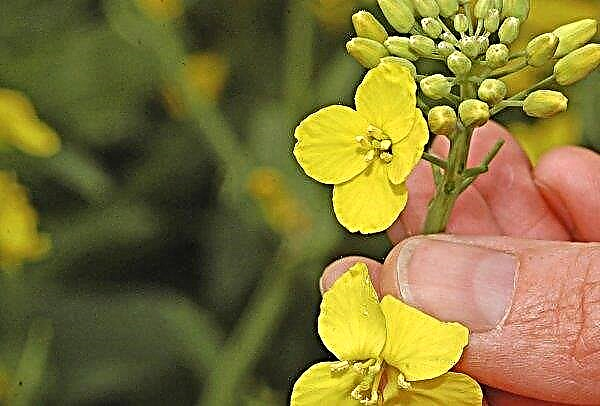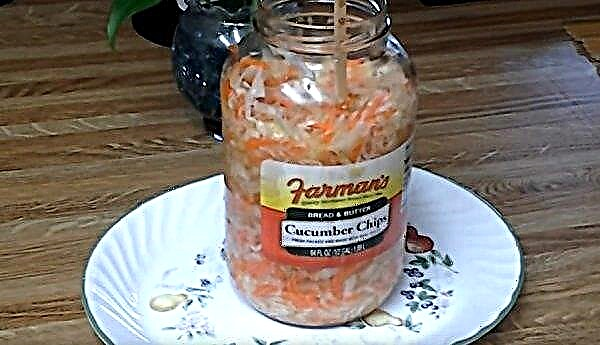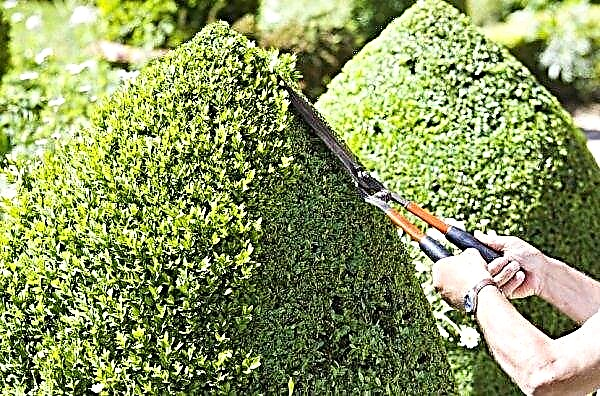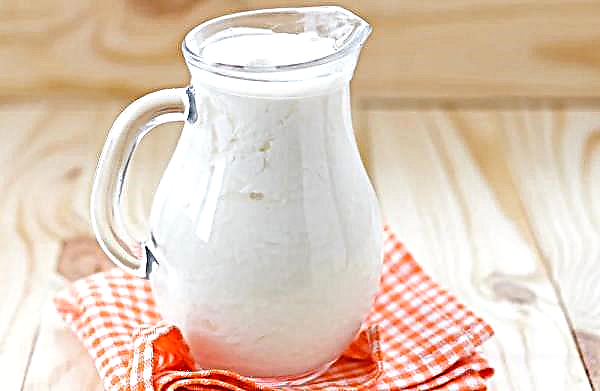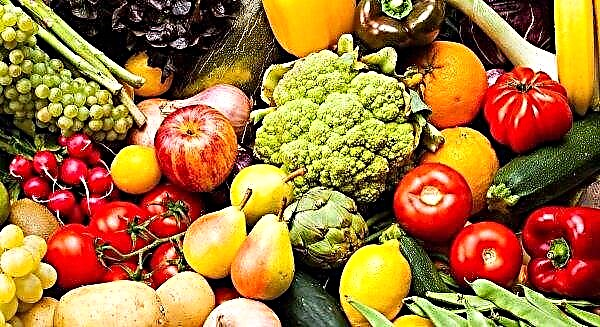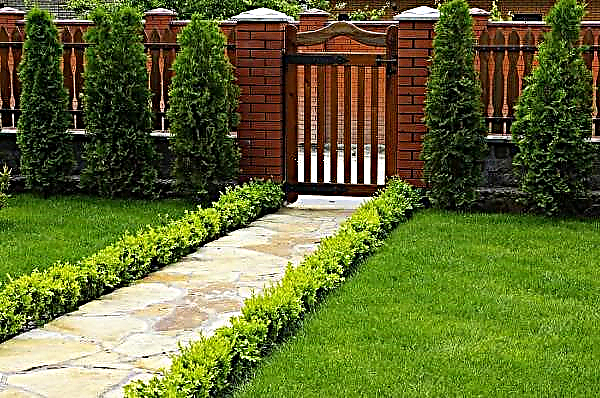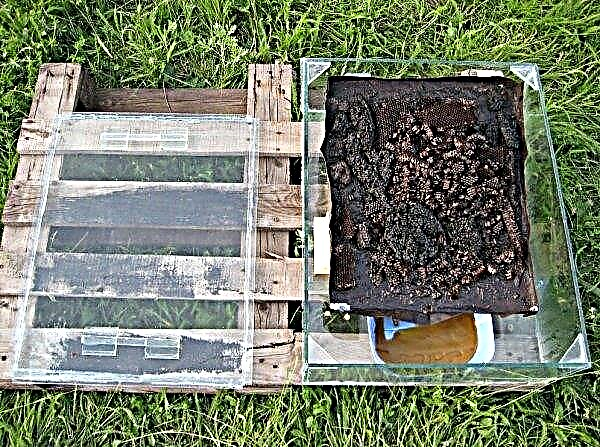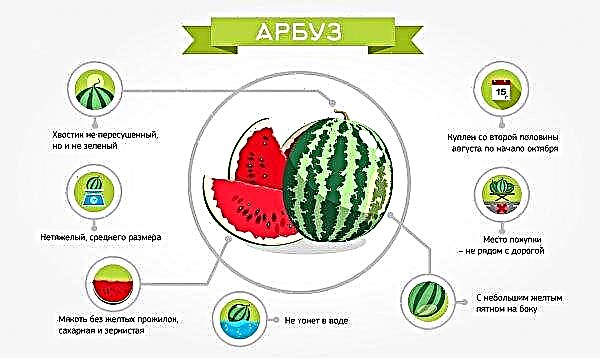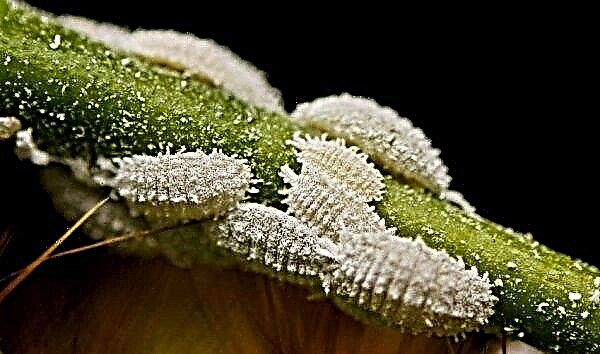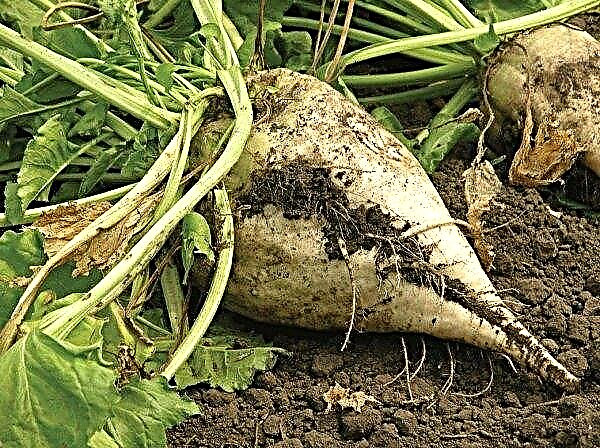Dessert grape variety Aleshechkin zoned in almost all regions of our country. The culture has its own characteristics and refers to plants of medium difficulty growing. How to plant and care for Aleshenkin grapes correctly will be discussed below.
Selection history
Alyoshkin grape variety was bred in the middle of the twentieth century. Volgograd plant breeder Tsekhmistrenko P. E. by pollination of Madeleine Anzhevin variety with pollen from Vostok variety. Immediately after breeding, the variety was cultivated only in the south of the country, but over time it spread to the northern regions.
Did you know? The oldest fruiting vineyard in the world is 400 years old. It is located in Slovenia, in the city of Maribor.
Detailed description and characteristic
Aleshenkin grapes are bushes of medium height. It forms a small amount of lateral shoots, each of which develops and bears fruit for 5 years. Then a bush update is required. The leaves are five-lobed, painted dark green, with pronounced veins. The edges of the serrated blades are often serrated. Petioles are closed, rounded.
Photo gallery
Bisexual flowers are light green in color. On the shoots, 2 inflorescences are laid. Fruit buds are planted annually, but with age more clusters with reduced grapes appear on old shoots. After pollination, large pyramidal clusters are formed, with loosely located oval-shaped grapes. This arrangement of berries contributes to the complete warming of the bunch on all sides by the sun's rays and increase sugar content. The berries are covered with delicate crisp skin. In the phase of technical maturity, the color of the berries is light green; upon reaching physical maturity, they acquire an amber-yellow hue, less often slightly red. Most grapes are seedless. The pulp is juicy with a high sugar content.
Productivity and ripening dates
Variety Aleshenkin refers to varieties of early ripening. From the moment of laying the kidneys to physical maturity, 118 days pass. The weight of large clusters varies within 1.9 kg. From one bush in the season you can collect 23-25 kg of berries.
Did you know? When pruning the vine in spring, juice is secreted, popularly referred to as "tears of the vine." It was believed that a person who drinks a grape tear in the spring will be able to get rid of grief and setbacks for a whole year.
The purpose of the variety
Due to the high sugar content of the fruit, the dessert variety Aleshenkin is suitable for:
- fresh use;
- homemade wine production;
- cooking various dessert dishes.

Advantages and disadvantages
Consideration of varietal characteristics with all the advantages and disadvantages allows you to moderate the conditions of cultivation and care, in order to increase productivity.
- Culture Benefits:
- high productivity;
- good adaptability to climate conditions of different regions;
- high taste;
- a rare arrangement of berries in a bunch;
- the possibility of self-pollination.
- The disadvantages of culture are:
- medium resistance to fungal diseases and pests;
- tendency to pea;
- poor resistance of the root system to frost.
Features of grape planting
Before planting grapes, you need to select a site and prepare the soil on it, given its mechanical composition.
Landing time
Planting of seedlings is carried out in the spring, when the soil warmed up to at least + 10 ° C, and the average daily temperature is +18 ... + 20 ° C. In different regions, landing dates will vary:
- in the south - the end of April;
- in the middle lane and the north - mid-end of May.
Choosing a place and preparing seedlings
The variety is demanding on lighting and does not tolerate shade, so it is better to plant planting material in the southern and south-western areas, closed from the draft. The ideal option is the south or southwest wall of utility rooms. The distance from the foundation when planting next to the premises should be at least 0.5 m. It is also important to take into account the proximity of the location of groundwater, since the culture does not tolerate overmoistening. The optimum distance to groundwater is 2 m.
Step-by-step process of preparing seedlings for planting:Important! Grapes can be used as a support, next to growing trees and shrubs, which will negatively affect development and can cause them to die. When planting, it is better to exclude the options for the proximity of grapes to any plants.
- Remove dewy roots - they will interfere with the development of the plant, drawing all moisture from the upper layers of the soil, which will reduce the survival rate of planting material.
- Renew calcaneal roots by making a small cut (3-5 mm).
- Shorten young shoots by 2–4 eyes.
- In the presence of well-ripened stepsons, the 1-2 lower ones can be left by shortening them by 2 eyes.
- Treat all sections with wood ash.
- Focusing on the moisture content of the root, it must be immersed in water for 1-2 days.
- Immediately before planting, immerse the roots in a talker consisting of diluted 1: 1 water of manure and peat.
 Instead of dung talkers, you can use a solution with root growth accelerator. The solution is made by adding 1 tbsp. l root root in 10 liters of water. The roots are immersed in such a mixture for 2 hours.
Instead of dung talkers, you can use a solution with root growth accelerator. The solution is made by adding 1 tbsp. l root root in 10 liters of water. The roots are immersed in such a mixture for 2 hours.Fundamental rules
Soil preparation for planting is carried out in the fall, during the harvest season. Immediately after this, the site must be cleaned of plant debris, weed roots, etc. Grapes grow well on soils with a high nutritional composition and light structure. Ideal black soil, but such soils are not found everywhere, so its condition needs to be improved independently.
First, the soil is dug up to a depth of 30 cm and watered with a 1% solution of copper sulfate. After 3 days, fertilizers are applied at the rate of 10 kg of manure or compost + 500 g of superphosphate per m². Too heavy soils are facilitated by adding river sand mixed 1: 1 with peat, 10 kg per 1 m². It is important to monitor the acidity of the soil. The optimal indicator is 5-6 pH. High acidity can be adjusted by adding 40 g of dolomite flour per m².
A week later, when the soil is fully prepared, the formation of holes can begin. The size of the landing pit is 80 × 70 × 70 cm. The bottom of the pit must be covered with drainage. For this, expanded clay or crushed stone is suitable. In the spring, a week before planting, the soil is mixed with:
In the spring, a week before planting, the soil is mixed with:
- 10 kg of sand;
- 10 kg of humus;
- 50 g nitrofoski;
- 50 g of superphosphate.
Growing and further care
Proper care of Aleshenkin grapes is the key to a rich harvest. The growing process involves the implementation of a number of activities, taking into account the phases of plant vegetation.
Watering and fertilizing
After planting, plants need abundant watering. Each bush takes 20 liters of water. Watering is carried out once a week for the whole month from the moment of planting. From the second month, moisture is applied once every 2 weeks, from the third to the end of the year - once a month. Weather conditions are also taken into account. If there is enough rainfall, watering is not carried out.
Adult bushes are watered only during the period of drought, in the spring before flowering and in the autumn after harvesting. Such a watering schedule is optimal for grapes of this variety. With increased humidity, there is a tendency to the spread of fungal diseases and pests. Fertilizing is combined with irrigation. They begin to make them from the second year of life of plants on the site. In the initial phase of the growing season (spring), plants need nitrogen to form a healthy green mass. To do this, the soil is fertilized during the spring irrigation with urea, 40 g per 10 l of water for each bush.
Fertilizing is combined with irrigation. They begin to make them from the second year of life of plants on the site. In the initial phase of the growing season (spring), plants need nitrogen to form a healthy green mass. To do this, the soil is fertilized during the spring irrigation with urea, 40 g per 10 l of water for each bush.
You can also use organic fertilizers, for example, chicken droppings: 100 g of droppings are added to 10 liters of water. Before flowering, potassium salts of 5 g per bush and 20 g of superphosphate are added. After flowering, the soil is fed with compost - 5 kg per bush. It can be applied in liquid form diluted in 5 l of water or bury to a depth of 5 cm in the soil. After harvesting, 5 g of potassium salt is added to the bush and 40 g of dolomite flour per bush.
Trimming and shaping a bush
Pruning is done in autumn and spring. The procedure involves removing branches that no longer bear fruit, shortening overgrown shoots, which can significantly increase productivity. From shoots leave from 3 to 9 eyes, based on the size of the plot and the age of the plants.
The laying of fruit buds occurs annually, but when forming pruning on the shoots leave no more than 1 inflorescence. In total, 35–40 inflorescences remain on the bush. This allows you to reduce the risk of peeling and achieve uniform ripening of the crop. At the stage of berry formation, excess leaves are also removed that prevent sunlight from entering the fruits. Every 5-6 years, you need to rejuvenate the bush, as the lashes bear fruit only 5 years. To do this, in the spring choose the strongest young shoot, leave up to 9 eyes on it. When a new sleeve is formed, the old one is cut off with a hacksaw under the stump. After trimming, each slice is treated with garden var.
Every 5-6 years, you need to rejuvenate the bush, as the lashes bear fruit only 5 years. To do this, in the spring choose the strongest young shoot, leave up to 9 eyes on it. When a new sleeve is formed, the old one is cut off with a hacksaw under the stump. After trimming, each slice is treated with garden var.Soil mulching
After watering, rain and fertilizing, the soil around the stem is loosened, simultaneously removing weeds, to a depth of 10 cm. Then the earth around the stem is mulched. For this, wood chips, straw or humus are suitable. This approach allows you to protect the root system from overheating and to retain moisture in the soil for a long time. In addition, the mulch gradually decomposes, gives nutrients to the soil.
Important! Add sugar to the mulch (100 g per 10 kg of mulch) to increase the sugar content of grapes and enrich the soil with calcium.
Breeding methods
Aleshenkin grape variety can propagate in several ways:
- Seed - applies only to areas of industrial importance. A hybrid loses its qualities when propagated by seeds, so it will be necessary to vaccinate other varieties, which pushes the fruiting time.

- Cuttings - the method most often used in home cultivation. Cutting of cuttings is carried out during the spring pruning. Suitable planting material must contain at least 4 active buds. Treated with copper sulfate rooted cuttings in the ground, deepening by 3 cm. Then carry out standard care.

- Layering - Another easy way to get a new plant at home. They bend a long whip and sprinkle with soil. After 4 weeks, when the shoot takes root, it is disconnected from the mother plant, and the section is treated with garden var.

Seasonal Care
Knowledge of the characteristics of the plant’s vegetation will help to draw up an optimal schedule of seasonal work with the vineyard in spring and summer:
- In mid-April, active sap flow and awakening of the root system begins - using a pitchfork, lift the vine from under the shelter to ensure air circulation, and cover with dry hay.
- Cover the soil with fertilizers and loosen it.
- At the end of April, remove the shelter and leave the whips until the kidneys swell.
- When the kidneys begin to swell, treat with a 1% solution of Bordeaux fluid.
- In early May, tie last year's shoots and long sleeves to the first and second trellis wire, securing them in a horizontal position.
- Lift the soil in the tambour circle to a depth of 5–10 cm, in rows between rows - 15–20 cm, then mulch with humus.
- In the phase of bud budding and the formation of new shoots, normalize when the shoots reach a length of 3-5 cm. Shoots that have blossomed at the base of the stem and on perennial sleeves are subject to removal.
- In early June, tie the new growing shoots upright to the trellis.
- Fertilize, loosen and mulch.
- In the flowering phase, shorten the shoots by 3 cm, eliminate unnecessary peduncles and all antennae.
- In the phase of growth and pouring berries, remove the antennae, fertilize, loosen and mulch the soil.
Shelter for the winter
After harvesting, you need to start preparing plants for winter. When the fruits are harvested, no work is done for 1-2 weeks to allow the plants to replenish the supply of nutrients. Then follows the introduction of fertilizers, seasonal pruning of vines, dew roots, which are at a depth of 5 cm, and water-charging watering of 50 liters per bush.
After pruning, gather the vine in a sheaf and tie. Lay the spruce branches or soft hay on the ground to allow airing, and lay the vine on the floor. Build a temporary shelter above the vine that can be easily removed in spring, for example, a wooden pallet. It is important that there is a distance of 10 cm between the pallet and the vine. On top of the shelter, lay a waterproofing material - tarpaulin or dense polyethylene. Sprinkle the surface of the waterproofing material with dry foliage.
Disease and Pest Prevention
Preventive treatment of the vineyard with a 1% solution of Bordeaux liquid from diseases and pests is carried out 3 times per season:
- in the spring after removal of the shelter;
- 20 days after the first;
- after harvesting.
Did you know? The weight of the largest bunch of grapes in the world was 9.398 kg. Such a crop was obtained in 1984 in Chile.
Aleshenkin grapes belong to demanding cultivated plants with their advantages and disadvantages. Creating full conditions for its development will not be difficult if you study the characteristics of the variety and, in accordance with them, draw up a seasonal work plan.



